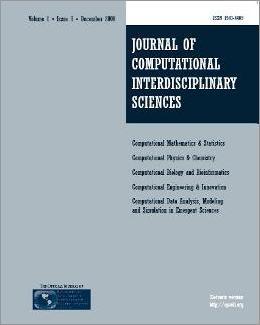
Editorial Office:
Management:
R. S. Oyarzabal
Technical Support:
D. H. Diaz
M. A. Gomez
W. Abrahão
G. Oliveira
Publisher by Knobook Pub


Editorial Office:
Management:
R. S. Oyarzabal
Technical Support:
D. H. Diaz
M. A. Gomez
W. Abrahão
G. Oliveira
Publisher by Knobook Pub
doi: 10.6062/jcis.2010.01.03.0026(Free PDF)
Werner Baumgarten and Marcus J. B. Hauser
The plasmodium of the slime mould Physarum polycephalum forms an extended and complex two-dimensional vein network that is used to transport protoplasm through the giant cell. To obtain insights into the topology of this vein network, its graph structure needs to be extracted from experimental images. This amounts to the task of extracting and reconstructing very tiny venules (elements) from an image that covers a relatively huge area. A protocol containing a sequence of image processing and correction steps that allows a highly accurate detection and extraction of the underlying graph has been developed and is described in detail. The analysis of the extracted data reveals that the veins and venules of the plasmodium of P. polycephalum form a regular, cubic graph.
Real world network, regular graph, Physarum polycephalum, data extraction.
[1] WATTS DJ & STROGATZ SH. 1998. Collective dynamics of 'small world' networks. Nature, 393: 440-442.
[2] ALBERT R & BARABASI A-L. 2002. Statistical mechanics of complexŽnetworks. Rev. Mod. Phys., 74: 47-97.
[3] BOCCALETTI S, LATORA V, MORENO Y, CHAVEZ M & HWANG DU. 2006. Complex networks: Structure and dynamics. Phys. Rep., 424:175-308.
[4] BARRAT A, BARTHELEMY M, PASTOR-SATORRAS R & VESPIGNANIŽA. 2004. The architecture of complex weighted networks. Proc. Natl.Acad. Sci USA, 101: 3747-3752.
[5] GUIMERA R, MOSSA S, TURTSCHI A & AMARAL LAN. 2005. The`worldwide air transportation network: Anomalous centrality, communitystructure, and cities' global roles. Proc. Natl. Acad. Sci USA, 102: 7794-7799.
[6] LI W & CAI X. 2007. Empirical analysis of a scale-free railway network in China. Physica A, 382: 693-703.
[7] DOMENECH A. 2009. A topological phase transition between small- Ž world and fractal scaling in urban railway transportation networks? Physica A, 388: 4658-4668.
[8] FAGIOLO G, REYES J & SCHIAVO S. 2009. World-trade web: Topological properties, dynamics, and evolution. Phys. Rev. E, 79: 036115.
[9] BARABASI AL, JEONG H, N Ž EDA Z, RAVASZ E, SCHUBERT A & Ž VICSEK T. 2002. Evolution of the social network of scientific collaborations. Physica A, 311: 590-614.
[10] LESS JR, SKALAK TC, SEVICK EM & JAIN RK. 1991. Microvascular architecture in a mammary carcinoma: Branching patterns and vessel dimensions. Cancer Res., 51: 265-273.
[11] BUHL J, GAUTRAIS J, SOLE RV, KUNTZ P, VALVERDE S, DENEU- Ž BOURG JL & THERAULAZ G. 2004. Efficiency and robustness in ant networks of galleries. Eur. Phys. J.B, 42: 123-129.
[12] BUHL J, GAUTRAIS J, DENEUBOURG JL, KUNTZ P & THERAULAZ G. 2006. The growth and form of tunneling networks in ants. J. Theor. Biol., 243: 287-298.
[13] WEARNE SL, RODRIGUEZ A, EHLENBERGER DB, ROCHER AB, HENDERSON SC & HOF PR. 2005. New techniques for imaging, digitization and analysis of three-dimensional neural morphology on multiple scales. Neurosci., 136: 661-680.
[14] MARWAN W. 2001. Photomovement and photomorphogenesis in Physarum polycephalum: Targeting of cytoskeleton and gene expression by light, in Hader D-P, Ledert M (eds.). Photomovements, Elsevier, š Amsterdam, pp. 561-587.
[15] UEDA T. 2005. An inteligent slime mold: A self-organizing system of cell shape and information, in Armbruster D, Kaneko K, Mikhailov AS (eds.). Networks of interacting machines, World Scientific, New Jersey, pp. 221-255.
[16] ADAMATZKY A & JONES J. 2008. Towards Physarum robots: Computing and manipulating on water surface. J.Bionic Eng., 5: 348-357.
[17] NAKAGAKI T, YAMADA H & TOTH Ž A. 2000. Maze-solving by an Ž amoeboid organism. Nature, 407: 470.
[18] NAKAGAKI T, KOBAYASHI R, NISHIURA Y & UEDA T. 2004. Obtaining multiple separated food sources: Behavioural intelligence in Physarum polycephalum. Proc. R. Soc. Lond. B, 271: 2305-2310.
[19] NAKAGAKI T, IIMA M, UEDA T, NISHIURA Y, SAIGUSA T, TERO A, KOBAYASHI R & SHOWALTER K. 2007. Minimum-risk path finding by an adaptive amoebal network. Phys. Rev. Lett., 99: 068104.
[20] NAIB-MAJANI W, OSBORN M, WEBER K, WOLFARTH-BOTTERMANN K-E, HINSSEN H & STOCKEM W. 1983. Immunochemistry of the acellular slime mould Physarum polycephalum. J. Cell Sci., 60: 13-28.
[21] KAGAWA Y & TAKAMATSU A. 2009. Synchronisation and spatiotemporal patterns in coupled phase oscillators on a weighted planar network. Phys. Rev. E, 79: 046216.
[22] AKITAYA T, OHSAKA S, UEDA T & KOBATAKE Y. 1985. Oscillations in intracellular ATP, cAMP and cGTP concentration in relation to rhythmical sporulation under continuous light in the myxomycete Physarum polycephalum. J. Gen. Microbiol., 131: 195-200.
[23] ZHANG T & SUEN C. 1984. A fast parallel algorithm for thinning digital patterns. Comm. ACM, 27: 236-239.